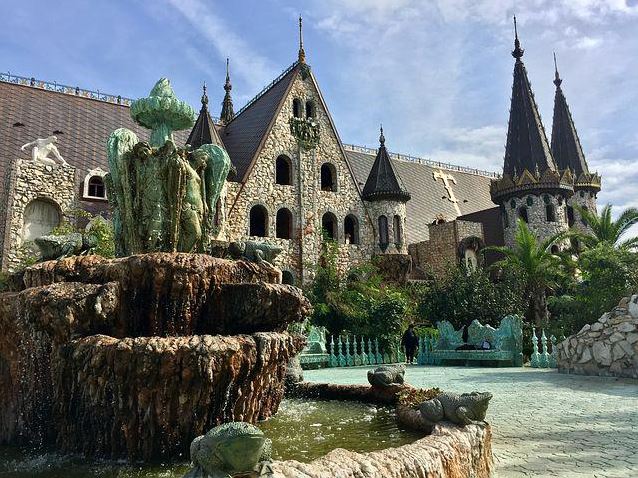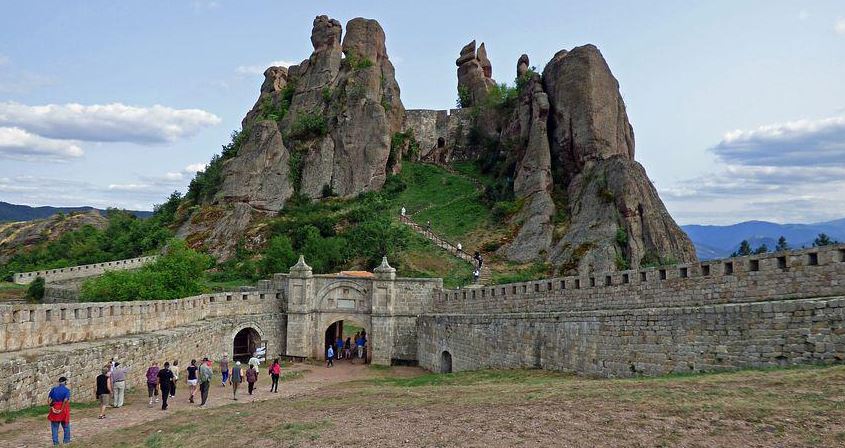Bulgaria is a great destination to see medieval fortifications, some of which date back to the first European empires: Thrace, Rome, Byzantium, and the Ottoman Empire. Because Bulgaria is at the crossroads of Europe, its history has been one of constant conflict. As long as there was a war going on in the Middle East, there was a conflict going on somewhere in the region. Because of this, over the decades there have been numerous magnificent castles and fortresses built in Bulgaria. These Bulgarian castles offer more than just a glimpse into the country’s rich past to visitors.
Most beautiful castles in Bulgarian history
1. The Fortress of Belogradchik
Fortress Belogradchik stands out as one of Bulgaria’s most stunning examples of medieval architecture. Located on the north slopes of the Balkan Mountains near the Bulgarian town of Belogradchik, the Belogradchik Castle also known as Kaleto is an ancient fortress.
Fortresses were first built in the Roman era, taking advantage of the area’s naturally occurring rock structures for defense purposes. When the Belogradchik Fortress was first built, it was primarily used for surveillance rather than defense. In the 14th century, Vidin Ivan Stratsimir, Bulgaria’s ruler, built defensive garrisons in front of the existing rock massifs to extend the previous stronghold. Stratsimir made the Belogradchik Fortification one of the region’s most important fortresses, second only to Vidin, Baba Vida, the tsar’s main fortress.
2. Shumen Fortress
Close to the present town of Shumen is Bulgaria’s most significant architectural landmark, Shumen Fortress. This is a magnificently renovated castle, which was completed in 2015 and overlooks the town and surrounding scenery.
The fortress, which is now a part of the Shumen Plateau Nature Park, is one of Bulgaria’s oldest fortresses. Historic ties to an Iron Age settlement that was later taken by the Thracians can be found at Shumen Fortress.
3. Castle of Ravadinovo
The Castle of Ravadinovo, in contrast to the other Bulgarian castles listed above, has a completely different function. One of Europe’s most stunning castles is just a few kilometers away from Sozopol in Bulgaria. It’s been likened to legendary castles like Neuschwanstein Castle because of its elaborate steeples and towers, intricate architecture, and decorations.
This Bulgarian castle is unique in that it is a relatively new construction. Only a single individual erected the “In Love with the Wind” castle over the course of 20 years. In spite of the fact that it was built to fulfill a single man’s goal of creating a lakeside retreat with gardens blooming with black swans, the Swan Lake Resort is an incredible tourist destination and one of Bulgaria’s most popular attractions. There are many who will fall in love with this castle, while others will find it unusual place to visit in Bulgaria.
4. Cherven Fortress
In 1235, the Bulgar Orthodox Bisphoric of Cherven moved into the Cherven Fortress. Located in north-eastern Bulgaria, it was a military, administrative, and cultural hub. The Ottomans captured the castle in 1388, ransacking it and leaving it in ruins. The 40-foot tower was all that was left, and it still remains today. The first fortification consisted of a town within a town with specialized trades such as blacksmiths, goldsmiths, potters, bakers, and so on and so forth. In the area, it was well-known for its skilled craftspeople.
5. Palace of Balchik
A holiday home overlooking the Black Sea was commissioned by Queen Maria Alexandrina Victoria de Edinburg of Romania after she had spent a season there. When Balchik was part of Romania, this eclectic structure was built between 1924 and 1927. A personal minaret next to a chapel was constructed to meet Queen Marie’s every desire.
6. Castra Martis Castle
The Castra Martis is one of the few historic Roman Bulgarian castles that are still surviving in Bulgaria. There are two independent castrae built on the banks of the Voynishka river in Kula, Vidin district, between 3rd and 4th century AD. Fort Vrasha Chuka was built to guard the Vrasha Chuka pass in the Balkans, which runs from Vidin to Belgrade, and includes a quadriburg and the castra’s main body. While much of the castra is in ruins, the southeast tower still soars to a height of over 17 m.
7. Ktenia Castle
Located on the historic Bulgarian-Byzantine border, on the eastern slopes of the Balkans, Ktenia Castle is one of Bulgaria’s most beautiful Roman and medieval castles. The ruins of the Ktenia Castle, which can be found in Bulgaria’s Sungurlare Province approximately a kilometer northeast of the settlement of Lozarevo, are a popular destination for visitors. It is part of a network of forts intended to protect against invasions, including Rusokastro and Aytos, which are located to the southeast and east of the castle respectively. The beaches of Sozopol and Lake Mandrensko are well worth a visit.
8. Baba Vida Fortress
Vidin, in northeastern Bulgaria, is home to the imposing Baba Vida fortress, built in the thirteenth century. It has two circular walls and nine towers, three of which have been kept to their full medieval height. The fortification was built in the 10th century on the site of the Roman castle Bononia, which was demolished in the 8th century.
Osman Pazvantoglu was a resident of the stronghold during the Ottoman control of Bulgaria, where it served as a weapons storage facility and a prison, as well as a dwelling.
9. Vrana Palace
As Bulgaria’s old royal palace, Vrana Palace sits on the outskirts of Sofia, which is the country’s capital. Tsar Simeon II of Bulgaria and his wife Tsaritsa Margarita still call it home. Even though there were two palaces in Sofia, one of which was used for official functions, and one that was used for vacations, Vrana was where the royal family of Bulgaria spent the most of their time.
10. Asen’s Fortress
Within a short drive of Asenovgrad, in the Rhodope Mountains, stands Asen’s Fortress, a magnificent medieval fortress positioned high above the Asenitsa River. It’s a well-preserved fortress in a stunning setting. It’s virtually impregnable because it’s encircled on three sides by sheer vertical drops and only accessible from one side.
The Thracians inhabited the area, as evidenced by archeological finds, and the area was also occupied by the Romans. The fortress, on the other hand, is a medieval structure. After being taken over by the soldiers of the Third Crusade, Jerusalem underwent major reconstruction in the 13th century.

